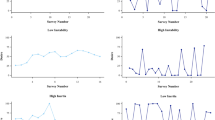Abstract
The ability of a reinforcer to maintain behavior decreases as a hyperbolic function of its delay. This discounted value can help explain impulsivity defined as the choice of an immediate, small reinforcer over a delayed, large reinforcer. Human operant studies using consumable reinforcers such as videos have found impulsivity with delays under 1 min. However, measures of discounting rates using questionnaires that describe hypothetical amounts of monetary reinforcers and delays of days, months, or years have found discounting rates that are much too low to explain impulsive choice in operant procedures. A comparison of discounting rates across questionnaire and operant studies indicates that questionnaires produce slower discounting because of the absence of both reinforcement and consumption processes. Combining reinforcement with questions about future reinforcers could facilitate the integration of questionnaire research into a behavioral framework.
Similar content being viewed by others
References
AINSLIE, G. (1975). Specious reward: A behavioral theory of impulsiveness and impulse control. Psychological Bulletin, 82, 463–496.
CHAPMAN, G. B. (2003). Time discounting of health outcomes, In George Lowenstein, Daniel Read, & Roy Baumeister (Eds.), Time and decision: Economic and psychological perspectives on intertemporal choice (pp. 395–418). New York: Russel Sage Foundation.
GREEN, L., MYERSON, J., & MCFADDEN, E. (1997). Rate of temporal discounting decreases with amount of reward. Memory & Cognition, 25, 715–723.
HYTEN, C., MADDEN, G. J., & FIELD, D. P. (1994). Exchange delays and impulsive choice in adult humans. Journal of the Experimental Analysis of Behavior, 62, 225–233.
JOHNSON, W. J., & BICKEL, W. K. (2002). Within-subject comparison of real and hypothetical money rewards in delay discounting. Journal of the Experimental Analysis of Behavior, 77, 129–146.
MAZUR, J. E. (1987). An adjusting procedure for studying delayed reinforcement. In M. L. Commons & J. E. Mazur (Eds.), Quantitative analysis of behavior (pp. 55–73). Hillsdale, NJ: Erlbaum.
MILLAR, A., & NAVARICK, D. J. (1984). Self-control and choice in humans: Effects of video game playing as a positive reinforcer. Learning and Motivation, 15, 203–218.
MOELLER, F. G., BARRATT, E. S., DOUGHERTY, D. M., SCHMITZ, J. M., & SWAIN, A. C. (2001). Psychiatric aspects of impulsivity. The American Journal of Psychiatry, 158, 1783–1793.
NAVARICK, D. J. (1982). Negative reinforcement and choice in humans. Learning and Motivation, 13, 361–377.
NAVARICK, D. J. (1986). Human impulsivity and choice: A challenge to traditional operant methodology. The Psychological Record, 36, 343–356.
NAVARICK, D. J. (1987). Reinforcement probability and delay as determinants of human impulsiveness. The Psychological Record, 37, 219–226.
NAVARICK, D. J. (1996). Choice in humans: Techniques for enhancing sensitivity to reinforcement immediacy. The Psychological Record, 46, 539–554.
NAVARICK, D. J. (1998). Impulsive choice in adults: How consistent are individual differences? The Psychological Record, 48, 665–674.
NAVARICK, D. J. (2001). Control of impulsive choice through biasing instructions. The Psychological Record, 51, 549–560.
NAVARICK, D. J., Bernstein, D. J., & Fantino, E. (1990). The experimental analysis of human behavior. Journal of the Experimental Analysis of Behavior, 54, 159–162.
NAVARICK, D. J., & FANTINO, E. (1976). Self-control and general models of choice. Journal of Experimental Psychology: Animal Behavior Processes, 2, 75–87.
PRELEC, D., & LOWENSTEIN, G. (1991). Decision making overtime and under uncertainty: A common approach. Management Science, 37, 770–786.
RAJALA, A. K., & HANTULA, D. A. (2000). Towards a behavioral ecology of consumption: Delay-reduction effects on foraging in a simulated internet mall. Managerial and Decision Economics, 21, 145–158.
Author information
Authors and Affiliations
Corresponding author
Rights and permissions
About this article
Cite this article
Navarick, D.J. Discounting of Delayed Reinforcers: Measurement by Questionnaires Versus Operant Choice Procedures. Psychol Rec 54, 85–94 (2004). https://doi.org/10.1007/BF03395463
Published:
Issue Date:
DOI: https://doi.org/10.1007/BF03395463




